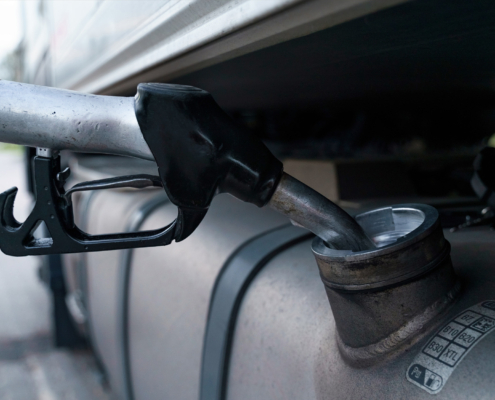Fuel Management Best Practices: From Rollout to ROI
Fuel is one of the highest costs for fleet-based businesses. Mastering fuel management best practices helps companies reduce waste, prevent theft, and maximize return on every gallon.
Fuel is one of the highest costs for fleet-based businesses. Mastering fuel management best practices helps companies reduce waste, prevent theft, and maximize return on every gallon.

Fuel is one of the most significant operating expenses for any business running a fleet of vehicles or heavy equipment. Every gallon impacts your bottom line, and even small inefficiencies can add up to thousands of dollars in wasted spend over time. Poor fuel oversight can also lead to theft, compliance issues, and operational delays that hurt productivity.
The solution is a comprehensive fuel management strategy, one that combines accurate tracking, strong policies, and the right technology. By doing so, businesses can take control of their fuel use, eliminate waste, and see measurable returns on their investment.
Let’s compare different fuel tracking methods so you can find out which one is right for you:
Some fleets still rely on handwritten logs or receipts to track fuel usage. While this may work for very small operations, manual tracking is time-consuming and prone to human error. It’s also hard to spot trends or quickly identify problems when data is scattered or incomplete.
Automated tracking is a game-changer. With tank sensors, pump controllers, and software dashboards, fuel data is captured in real time, ensuring you always have an accurate, up-to-date picture of your fuel consumption.
Real-time tracking lets managers make informed decisions quickly. If there’s a sudden drop in tank levels or a spike in usage, you can investigate right away before losses pile up. Accurate tracking also improves planning, so you always know how much fuel you have on hand and when it’s time to reorder.
Fuel theft is a common but often overlooked issue that quietly erodes profits. Whether it’s siphoning from tanks, unauthorized fueling, or fuel card misuse, theft can add up to major losses over the course of a year.
Taking proactive steps to secure your fuel supply not only reduces shrinkage but also creates a culture of accountability across your team.
Here’s how you can stay compliant with changing regulations:
Fuel usage data isn’t just useful for operations, it’s often required for compliance. Many businesses must maintain detailed records for tax reporting, fuel rebates, or EPA requirements. Missing or inaccurate data can result in penalties, lost rebate opportunities, or increased audit risk.
Fuel management systems automatically log every transaction, including date, time, volume, and user. This eliminates manual recordkeeping and ensures that your reports are complete and audit-ready. When tax season comes around, you can easily generate detailed summaries without spending hours piecing together paperwork.
Modern fuel management starts with reliable equipment. Tank level sensors provide accurate readings of how much fuel you have on hand. Pump controllers measure exactly how much is dispensed with each use. GPS devices can verify that fuel is being used at authorized locations. Together, these tools give you a clear, comprehensive picture of fuel usage across your entire operation.
Pairing hardware with a powerful software platform unlocks even more value. Cloud-based dashboards allow you to monitor tanks and equipment in real time, generate reports instantly, and receive alerts about unusual activity. Mobile accessibility ensures managers can stay informed whether they’re at the office or in the field.
Fuel is too valuable to leave untracked. Link2Pump’s fuel management solutions provide the tools you need to reduce waste, prevent theft, and stay compliant, all while improving ROI.
A fuel management system is only as effective as the people using it. Investing in training ensures that your team understands not just how to use the tools, but why accurate fuel tracking matters.
Training also helps foster a culture of transparency, where employees take ownership of fuel efficiency and waste reduction.
Collecting data is only the first step—you need to use it to drive improvement. Regularly reviewing key metrics helps you identify trends, spot inefficiencies, and make informed decisions.
These insights allow managers to refine routes, improve scheduling, and reduce unnecessary consumption, all of which add up to better ROI.
Even with good technology, some companies struggle to see results because they fall into common traps. Avoid these mistakes:
Proactively addressing these challenges ensures you get the most out of your investment.
The ultimate goal of a fuel management program is to deliver measurable value. Track cost savings, theft reduction, and time saved on administrative tasks. Share these results with leadership to demonstrate the program’s impact and build buy-in for future improvements.
ROI isn’t just about money saved: it’s about efficiency gained, compliance risks reduced, and smoother operations across your entire fleet.
Fuel management doesn’t end with implementation, it’s an ongoing process of measurement, optimization, and accountability. With the right combination of technology, policies, and training, you can turn fuel management into a strategic advantage that strengthens your bottom line.
Fuel management is more than a cost-control measure, it’s a strategic investment in your business. By combining the right technology, strong policies, and team training, you can protect profits and gain full visibility into one of your most important resources. Contact Link2Pump today to learn how our fuel management systems can help your company go from rollout to measurable ROI.

 https://www.link2pump.com/wp-content/uploads/2025/10/Preventing-Fuel-Theft-in-Landscaping-and-Golf-Course-Operations.jpg
1250
2000
Abstrakt Marketing
https://www.link2pump.com/wp-content/uploads/2025/08/link2pump-Logo-1.png
Abstrakt Marketing2025-10-02 14:27:342025-11-20 12:31:44A Guide to Fuel Theft Prevention in Landscaping
https://www.link2pump.com/wp-content/uploads/2025/10/Preventing-Fuel-Theft-in-Landscaping-and-Golf-Course-Operations.jpg
1250
2000
Abstrakt Marketing
https://www.link2pump.com/wp-content/uploads/2025/08/link2pump-Logo-1.png
Abstrakt Marketing2025-10-02 14:27:342025-11-20 12:31:44A Guide to Fuel Theft Prevention in Landscaping https://www.link2pump.com/wp-content/uploads/2025/05/How-Smart-Fuel-Allocation-Can-Increase-Your-Mining-Fleets-Productivity.jpg
1250
2000
Abstrakt Marketing
https://www.link2pump.com/wp-content/uploads/2025/08/link2pump-Logo-1.png
Abstrakt Marketing2025-05-22 10:17:502025-11-20 12:31:47How Smart Fuel Allocation Can Increase Your Mining Fleet’s Productivity
https://www.link2pump.com/wp-content/uploads/2025/05/How-Smart-Fuel-Allocation-Can-Increase-Your-Mining-Fleets-Productivity.jpg
1250
2000
Abstrakt Marketing
https://www.link2pump.com/wp-content/uploads/2025/08/link2pump-Logo-1.png
Abstrakt Marketing2025-05-22 10:17:502025-11-20 12:31:47How Smart Fuel Allocation Can Increase Your Mining Fleet’s Productivity https://www.link2pump.com/wp-content/uploads/2023/12/Fuel-Fleet-Management-Best-Practices-.jpg
1250
2000
Abstrakt Marketing
https://www.link2pump.com/wp-content/uploads/2025/08/link2pump-Logo-1.png
Abstrakt Marketing2023-12-15 10:24:152025-11-20 12:31:57Fuel Fleet Management Best Practices
https://www.link2pump.com/wp-content/uploads/2023/12/Fuel-Fleet-Management-Best-Practices-.jpg
1250
2000
Abstrakt Marketing
https://www.link2pump.com/wp-content/uploads/2025/08/link2pump-Logo-1.png
Abstrakt Marketing2023-12-15 10:24:152025-11-20 12:31:57Fuel Fleet Management Best Practices https://www.link2pump.com/wp-content/uploads/2023/12/What-Are-the-Advantages-of-an-Automated-Fuel-Management-System.jpg
1250
2000
Abstrakt Marketing
https://www.link2pump.com/wp-content/uploads/2025/08/link2pump-Logo-1.png
Abstrakt Marketing2023-12-11 09:00:002025-11-20 12:31:58What Are the Advantages of an Automated Fuel Management System?
https://www.link2pump.com/wp-content/uploads/2023/12/What-Are-the-Advantages-of-an-Automated-Fuel-Management-System.jpg
1250
2000
Abstrakt Marketing
https://www.link2pump.com/wp-content/uploads/2025/08/link2pump-Logo-1.png
Abstrakt Marketing2023-12-11 09:00:002025-11-20 12:31:58What Are the Advantages of an Automated Fuel Management System? https://www.link2pump.com/wp-content/uploads/2023/09/RevolutionizingtransportandlogisticsharnessingchatGPTandAI.png
609
1081
Nate Riggins
https://www.link2pump.com/wp-content/uploads/2025/08/link2pump-Logo-1.png
Nate Riggins2023-09-05 12:26:142025-11-20 12:31:58Revolutionizing Transport and Logistics: Harnessing ChatGPT and AI
https://www.link2pump.com/wp-content/uploads/2023/09/RevolutionizingtransportandlogisticsharnessingchatGPTandAI.png
609
1081
Nate Riggins
https://www.link2pump.com/wp-content/uploads/2025/08/link2pump-Logo-1.png
Nate Riggins2023-09-05 12:26:142025-11-20 12:31:58Revolutionizing Transport and Logistics: Harnessing ChatGPT and AI https://www.link2pump.com/wp-content/uploads/2023/09/HeavyfleetsustainabilityHowfuelmanagementcontributestoenvironmentalgoals.png
609
1081
Nate Riggins
https://www.link2pump.com/wp-content/uploads/2025/08/link2pump-Logo-1.png
Nate Riggins2023-08-29 14:50:052025-11-20 12:31:59Heavy Fleet Sustainability: How Fuel Management Contributes to Environmental Goals
https://www.link2pump.com/wp-content/uploads/2023/09/HeavyfleetsustainabilityHowfuelmanagementcontributestoenvironmentalgoals.png
609
1081
Nate Riggins
https://www.link2pump.com/wp-content/uploads/2025/08/link2pump-Logo-1.png
Nate Riggins2023-08-29 14:50:052025-11-20 12:31:59Heavy Fleet Sustainability: How Fuel Management Contributes to Environmental Goals https://www.link2pump.com/wp-content/uploads/2023/09/FrommixerstopumpsHowfuelmanagementsystemsimproveconcretedelivery.png
609
1081
Nate Riggins
https://www.link2pump.com/wp-content/uploads/2025/08/link2pump-Logo-1.png
Nate Riggins2023-08-23 12:00:052025-11-20 12:31:59From Mixers to Pumps: How Fuel Management Systems Improve Concrete Delivery
https://www.link2pump.com/wp-content/uploads/2023/09/FrommixerstopumpsHowfuelmanagementsystemsimproveconcretedelivery.png
609
1081
Nate Riggins
https://www.link2pump.com/wp-content/uploads/2025/08/link2pump-Logo-1.png
Nate Riggins2023-08-23 12:00:052025-11-20 12:31:59From Mixers to Pumps: How Fuel Management Systems Improve Concrete Delivery

link2pump offers fuel management systems that allow business to move from the clipboard to the cloud.
This site uses cookies. By continuing to browse the site, you are agreeing to our use of cookies.
AcceptLearn moreWe may request cookies to be set on your device. We use cookies to let us know when you visit our websites, how you interact with us, to enrich your user experience, and to customize your relationship with our website.
Click on the different category headings to find out more. You can also change some of your preferences. Note that blocking some types of cookies may impact your experience on our websites and the services we are able to offer.
These cookies are strictly necessary to provide you with services available through our website and to use some of its features.
Because these cookies are strictly necessary to deliver the website, refusing them will have impact how our site functions. You always can block or delete cookies by changing your browser settings and force blocking all cookies on this website. But this will always prompt you to accept/refuse cookies when revisiting our site.
We fully respect if you want to refuse cookies but to avoid asking you again and again kindly allow us to store a cookie for that. You are free to opt out any time or opt in for other cookies to get a better experience. If you refuse cookies we will remove all set cookies in our domain.
We provide you with a list of stored cookies on your computer in our domain so you can check what we stored. Due to security reasons we are not able to show or modify cookies from other domains. You can check these in your browser security settings.
We also use different external services like Google Webfonts, Google Maps, and external Video providers. Since these providers may collect personal data like your IP address we allow you to block them here. Please be aware that this might heavily reduce the functionality and appearance of our site. Changes will take effect once you reload the page.
Google Webfont Settings:
Google Map Settings:
Google reCaptcha Settings:
Vimeo and Youtube video embeds: